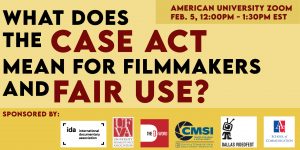 A new law creates a small-claims venue for copyright infringement claims. What could possibly go wrong?
A new law creates a small-claims venue for copyright infringement claims. What could possibly go wrong?
In December, the CASE Act (for Copyright Alternative in Small-Claims Enforcement) was quietly slipped into must-pass legislation. Pushed heavily by large copyright holders and batted down by copyright-flexibility advocates for years, it is now law. It could affect how creators of all kinds, including filmmakers, experience the employment of fair use in practice.
On Feb. 5, the Center for Media & Social Impact in conjunction with its partners—University Film and Video Association’s Documentary Working Group, D-Word, International Documentary Association, Dallas Videofest, and AU’s School of Communication, hosted a webinar, “What Does the CASE Act Mean for Filmmakers and Fair Use?” The recorded livestream of the webinar is available on the School of Communication’s YouTube channel.
Fair use, it’s important.
Fair use is the right to re-use copyrighted material without licensing it or even getting permission. It’s become ever more valuable as a basic feature of copyright law, as copyright monopolies have gotten longer, covered more and more kinds of material, and as copyright has become default upon creation.
Without fair use, copyright monopolies become de-facto private censorship of all future creative work. It would mean always having to ask permission from creators of existing work even to refer to your own culture. For journalists, it would mean getting permission to quote from documents, or to show viewers a clip from a controversial film they’re commenting on. For filmmakers, it would mean getting permission for a ringtone that appears in a verité scene, for illustrative material (“the incident blanketed the news,” with a collage of news items), for a historical reference (“that was the first of many attempts to get national health insurance”), or media criticism (“misogyny is a feature of videogames”). For creators on online courseware, it would mean getting permission for everything from art in the background of a lecture to examples referred to in a slideshow. And so on. The world is copyrighted these days.
So fair use has become a precious tool in any creator’s toolkit.
Fair use and filmmakers.
 As leading attorney Michael Donaldson explained, fair use has become, in the last 15 years, a crucial resource for filmmakers, both for documentary and fiction films. In 2005, when the Documentary Filmmakers’ Statement of Best Practices in Fair Use came out (Donaldson was instrumental in the creation of this work, which was facilitated through the Center for Media & Social Impact and American University’s law school), Donaldson’s firm handled no films with fair use claims. Last year, the great majority of the 350 films his firm worked on incorporated fair use claims, without any problem. In 2005, no errors and omissions insurers accepted fair use claims in documentary films routinely; by 2006, with the clarity of the best practices, all insurers were accepting them. It has remained standard practice.
As leading attorney Michael Donaldson explained, fair use has become, in the last 15 years, a crucial resource for filmmakers, both for documentary and fiction films. In 2005, when the Documentary Filmmakers’ Statement of Best Practices in Fair Use came out (Donaldson was instrumental in the creation of this work, which was facilitated through the Center for Media & Social Impact and American University’s law school), Donaldson’s firm handled no films with fair use claims. Last year, the great majority of the 350 films his firm worked on incorporated fair use claims, without any problem. In 2005, no errors and omissions insurers accepted fair use claims in documentary films routinely; by 2006, with the clarity of the best practices, all insurers were accepting them. It has remained standard practice.
In fact, he noted, with documentary filmmakers paving the way and creating a comfort zone around fair use, fair use practice has extended to fiction films as well. He pointed to the 2013 horror film Escape from Tomorrow, set and partly filmed in Disney World, as one example. Another was Room 237, which re-uses material from The Shining to tell a different story. Neither resulted in any blowback.
“Nobody should do anything differently today because of this law,” he urged filmmakers. “The law of fair use has been around for a long time.” When filmmakers use their rights, he argued, the law becomes even more useable for others.
The CASE Act.
The CASE Act addresses a really important problem for “little guy” independent creators. Too often, their work can get re-used in ways that aren’t fair use. Whether it’s large, unscrupulous companies or clueless enthusiasts, the original creator might be losing a licensing fee and the right to approve the new use. But going to court is really expensive, and they aren’t in a position to take the risk of losing.
The CASE Act is one of many potential ways to address that problem. It proposes a new venue to bring claims of copyright infringement. Instead of a judicial process, through the courts, it creates a new place, at the Copyright Office. What that place will look like exactly isn’t clear. The law basically punts all the implementation decisions to the Copyright Office, which is part of the Library of Congress–and which, as you might guess, reports to Congress.
But the law does stipulate that it will be available for claims up to $30,000 (half the annual income of the average American household). The process will be an administrative one; compare, say, to mediation. The decision-makers would probably be Copyright Office lawyers. It’s “voluntary,” in the sense that someone who’s been accused of infringement can refuse to go to this venue. In that case, the accuser could choose whether to go to the federal court process and sue there.
So what’s not to like?
The question isn’t whether it’s a good idea to help the “little guy” get redress for true infringement. As speaker Meredith Rose,  policy counsel for the think tank Public Knowledge, noted, the question is whether on balance, the plusses outweigh the minuses.
policy counsel for the think tank Public Knowledge, noted, the question is whether on balance, the plusses outweigh the minuses.
One big problem with the law, she noted, is whether it’s even constitutional. Given that there is a division of powers between the executive, legislative, and judicial, it’s a problem with the legislative branch creates judicial-style functions—without the usual protections of the judicial process—under its own branch.
But there are also practical problems, she pointed out. While the independent filmmaker might want the bar lowered to bring copyright claims, so do the so-called “copyright trolls.” These are unscrupulous firms that bring copyright complaints, usually without substance, in order to shake down unsuspecting users. Their best weapon is fear—fear of having to get a lawyer, fear of going to court, fear of having done something wrong. Not everyone has a copyright lawyer on speed-dial, or even knows exactly what their fair use rights are. The trolls have scared hundreds of thousands of people into paying them enough money for the trolls to make very good livings. The federal courts are now well aware of this, and have begun to take action to rein the bad actors in.
If copyright trolls can have a cheap, easy place to bring their charges, though, and one that isn’t subject to the regulations that have long accrued to the federal judicial process, that makes their threats that much more plausible. And now it’ll be even scarier to get a troll’s threatening letter, and people will be more likely to capitulate, whatever the legitimacy of their uses.
Also, she noted, even though the process hasn’t yet been established by the Copyright Office, the law permits, effectively, summary judgement for charges under $5,000, by one person, without the same kind of right of appeal that exists in the courts. This should frighten anyone.
Could there be a better version of this law? Of course, she replied. You could create a court within the judiciary, with all its protections. Within this version, the cap for damages could be reduced to the cost of a licensing fee plus some kind of small fine. And there is the possibility—if a lawsuit is brought—that the law could be repealed.
As well, she noted, organizations like Public Knowledge, as well as the Electronic Frontier Foundation, Fight for the Future (and I’ll add, Authors Alliance) are all tracking the implementation of the law at the Copyright Office. There will be opportunities to provide input. Creative communities like filmmakers will be crucially important voices.
Where the Rubber Hits the Road.
Dale Cohen, who runs UCLA’s Documentary Film Legal Clinic (as well as being special counsel for the public TV documentary series Frontline), also believes that it’s incredibly important for filmmakers to continue to assert their fair use rights.
 But he is worried about the CASE Act’s implications for filmmakers’ risk assessment. He’s afraid that the easy, fast, low-cost access of this new venue could lead to mass complaints whether grounded or not, often from smaller actors such as individual photographers. Such complaints could alarm insurers or distributors. “It can gum up the works for indie filmmakers,” he noted, even if it’s just a delay. So that reality may mean alerting filmmakers to increased risks, which can affect their creative process, even when it’s solidly grounded in the law. “There’s likely to be a logjam in the early stages,” he notes. He supported an effort to fix the law’s frailties and failures.
But he is worried about the CASE Act’s implications for filmmakers’ risk assessment. He’s afraid that the easy, fast, low-cost access of this new venue could lead to mass complaints whether grounded or not, often from smaller actors such as individual photographers. Such complaints could alarm insurers or distributors. “It can gum up the works for indie filmmakers,” he noted, even if it’s just a delay. So that reality may mean alerting filmmakers to increased risks, which can affect their creative process, even when it’s solidly grounded in the law. “There’s likely to be a logjam in the early stages,” he notes. He supported an effort to fix the law’s frailties and failures.
But at the same time, he encouraged filmmakers to continue to vigorously employ their fair use rights, at least until the actual venue is created and we can understand the risks in practice. “Fair use is designed to help storytellers tell new stories,” he noted.
On alert.
More than 1,000 people registered for the event, showing the concern that filmmakers have for protecting their fair use rights. Every speaker encouraged them to follow the events on the websites of the public interest sites that are tracking this issue. As the process of creating this venue continues, creators of all kinds will have a chance to show that they want an ability to hold bad actors of all kinds to account, and they don’t want bad actors to get yet one more place to do damage to creators.
